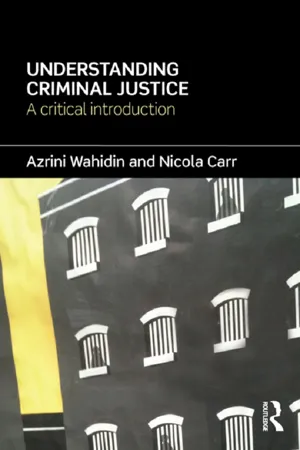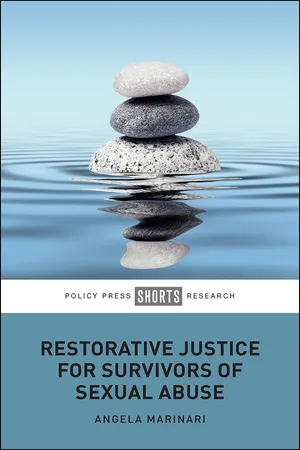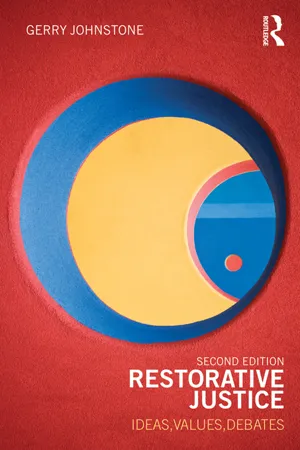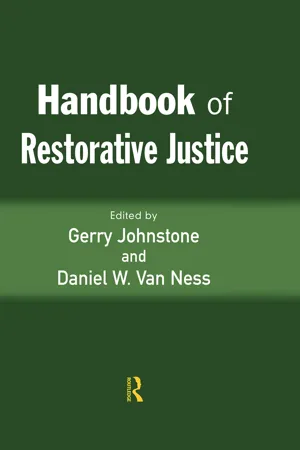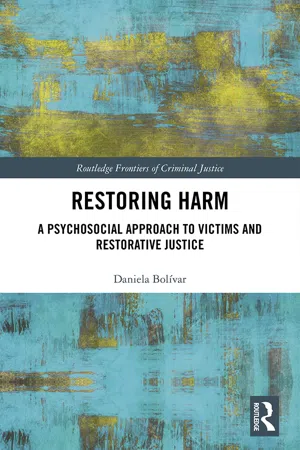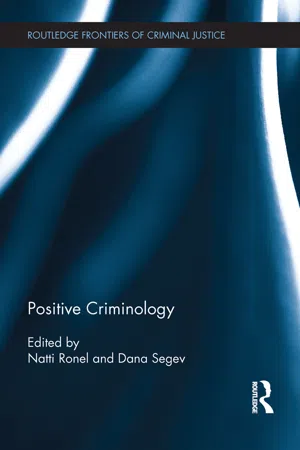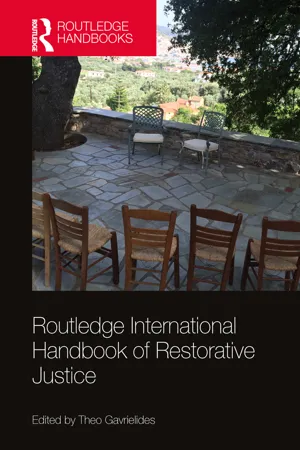Psychology
Restorative Justice
Restorative justice is a theory and practice that focuses on repairing harm caused by criminal behavior. It emphasizes the needs of victims and the community, as well as the responsibilities of offenders to make amends. This approach aims to promote healing and reconciliation, rather than solely punishing the offender.
Written by Perlego with AI-assistance
Related key terms
9 Key excerpts on "Restorative Justice"
- eBook - ePub
Understanding Criminal Justice
A Critical Introduction
- Azrini Wahidin, Nicola Carr(Authors)
- 2013(Publication Date)
- Routledge(Publisher)
This definition points to the fact that a broad range of interventions can be included under the remit of Restorative Justice. At its simplest level Restorative Justice can involve a facilitated meeting between the victim, offender and a representative of the community, in which there is a dialogue between the participants. The purpose of this dialogue is to allow the victim to articulate the harm caused by the offence and to enable the offender to take responsibility for the harm done. One of the desired outcomes of such an approach is that the offender commits to do something to ‘restore’ or put right the harm. This could involve making a commitment to undertake unpaid work, writing a letter of apology, paying compensation to the victim or engaging in a specific programme to address the causes of offending (Dignan, 2007).Bearing in mind the critiques of conventional models of justice, proponents of Restorative Justice argue that restorative approaches allow for a more meaningful engagement for all parties. As Morris (2002: 598) notes, Restorative Justice also emphasises human rights and the need to recognise the impact of social or substantive injustice and in small ways address these rather than simply provide offenders with legal or formal justice and victims with no justice at all. Thus it seeks to restore the victim’s security, self-respect, dignity and, most importantly, sense of control. And it seeks to restore responsibility to offenders for their offending and its consequences, to restore a sense of control to them to make amends for what they have done and to restore a belief in them that the process and outcomes were fair and just.Restorative Justice approaches are associated with a broad range of processes – a list of some common examples is provided in Box 8.3 . What characterises the interventions as being restorative - eBook - ePub
- Anna Eriksson(Author)
- 2013(Publication Date)
- Willan(Publisher)
Chapter 1
Restorative Justice: an introduction
Restorative Justice has been presented as a response to crime that promotes inclusive dialogue, acceptance of responsibility, reparation of harm, and rebuilding of relations among victims, offenders and communities (Christie 1977; Braithwaite 1989; Hayes et al . 1998; Walgrave 1998; Tutu 1999; Ahmed et al . 2001; Roche 2001; Strang and Braithwaite 2001). As one approach within the informal tradition of dispute resolution, Restorative Justice is most commonly used to describe non-adjudicative methods of solving conflict that give victims, offenders and the community a central role in decision making (Braithwaite 1989; Roach 2000). A fundamental tenet of the Restorative Justice paradigm is a shift in accountability – from offenders owing a debt to society for their criminal behaviour, to being directly accountable to their victim(s) (Corrado et al . 2003) – with a focus on problem solving and on repairing harm (Umbreit 1995).Restorative Justice has also been portrayed as an original and natural way of dealing with conflict (Zehr 1990; Van Ness 1993; Sullivan and Tifft 2001; Sullivan and Tifft 2006). As argued by Braithwaite (2002a), ‘Restorative Justice has been the dominant model of criminal justice throughout most of human history for perhaps all the world’s people’ (p. 5). He argues elsewhere that ‘Restorative Justice is grounded in moral intuitions of considerable resonance for most people because they have a long history, particularly in the spirituality of the world’s greatest religions’ (2003: 1). Daly (2002) has referred to such claims as ‘extraordinary’, and they have also been criticised for being somewhat romanticised and, as such, having a tendency to gloss over the negative aspects of restorative or informal justice in favour of highlighting the positives (Johnstone 2002; Roche 2003). - eBook - ePub
Women, Crime and Justice in Context
Contemporary Perspectives in Feminist Criminology from Australia and New Zealand
- Anita Gibbs, Fairleigh Gilmour, Anita Gibbs, Fairleigh Gilmour(Authors)
- 2022(Publication Date)
- Routledge(Publisher)
Dissatisfaction with formal criminal justice proceedings has led to the consideration of alternative approaches, including Restorative Justice. Cautiously used since the 1990s, the application of Restorative Justice practices in the field of gender-based violence has received growing attention. The question whether and to what extent Restorative Justice may be appropriate in the context of gender-based violence has been a major topic of debate. Before discussing the application of Restorative Justice in this context, an overview of Restorative Justice and its underlying values and principles is provided. The chapter then considers empirical research into the use of Restorative Justice in situations of gender-based violence and harm, including the effectiveness of restorative interventions. It focuses on violence experienced by women, and it refers to family, more specifically intimate partner violence, as well as sexual violence.Development, values and models of Restorative Justice
Restorative Justice is a diverse movement with practices embedded in various contexts within and outside the criminal justice system. It is an approach that places emphasis on repairing the harm caused to the victim by crime and wrongdoing. It understands crime as an injury to people and relationships, rather than an abstract violation of the law, and aims at addressing the needs of those involved arising from the harm (Zehr 1990 ). The development of this approach has been driven by practice rather than by theory.Restorative Justice has particularly gained momentum since the 1990s, when Restorative Justice initiatives experienced growth in various countries.5 It was first applied mainly in the area of youth justice and later extended to adult criminal law. To some extent, Restorative Justice has also been implemented in complex and sensitive cases; for instance, those that involve family violence and gendered harm. In Finland, for example, where Restorative Justice practice was strongly influenced by abolitionist thinking and Christie’s concept of the “re-appropriation of conflicts,” family violence cases have been dealt with through victim–offender mediation since the 1980s (Drost et al. 2015 ).6 The development of Restorative Justice provided a new paradigm for thinking about crime that aims to shift the focus from retribution towards restoration (Zehr 1990 - Marinari, Angela(Authors)
- 2020(Publication Date)
- Policy Press(Publisher)
1999 ) developed a view of Restorative Justice which posited that: as crime arises within the socio-economic relationships within a community – so that community can be highly influential in preventing and restoring crime. He saw such measures as predominately complementary to existing justice systems, whereby the community can achieve three aims: address the victim’s needs; reintegrate the offender; and undertake additional preventative activity to prevent recidivism. His definition of Restorative Justice is widely quoted:Restorative Justice is a process whereby parties with a stake in a specific offence collectively resolve how to deal with the aftermath of the offence and its implications for the future. (Marshall, 1999 , p 5)Marshall’s (1999 ) definition is perhaps so widely used as it is appreciated for its simplicity and succinctness. While describing Restorative Justice in a phrasing which encapsulates its essence, there is a vagueness as to the role of some central concepts in Restorative Justice. Being able to operationalise these is necessary to enhance our understanding as to how Restorative Justice works (Daly, 2014 ; Gang et al, 2019 ). There are three concepts of Restorative Justice that are particularly relevant to this study – community, dialogue and restoration.‘Community’ in Restorative JusticeThe role of the community as a positive force for change is central to many forms of Restorative Justice (Braithwaite, 1989 , 1999 ; Cunneen and Hoyle, 2010 ). Family group conferencing brings together the families of both victims and offenders, along with members of their community and some representative of the justice system or facilitator of some form, to discuss the harm caused and how it can be repaired (Umbreit and Zehr, 1996 ; Presser and Van Voorhis, 2002 ). It can promote the engagement of communities with the state while respecting cultural diversity (Pennell and Burford, 2002 ). Sentencing circles are similar forms of conference, though usually with wider representation from both the community and the formal justice process – their aim is achieving consensus and community support for sentencing decisions (Presser and Van Voorhis, 2002 ). They are often used with indigenous communities, who have less trust and confidence in the justice system (Lajeunesse, 1996 ; LaRocque, 1997 ; Stewart et al, 2001 ; Goel, 2010 ). These processes have been used to tackle sexual abuse and family violence. For example, the Family Group Decision Making Project in Newfoundland and Labrador, Canada, tested the ability of family conferencing to reduce family violence, finding it an effective strategy for eliminating both child and intimate partner abuse (Pennell and Burford, 2000 , 2002 ). Similar reductions in abuse were presented from the Hollow Water Community Holistic Circle Healing program in Canada (Ross, 1996 ; Couture, 2001 ) although the reliability of these findings has subsequently been challenged (Dickson-Gilmore and La Prairie, 2005 ). These forms of arrangements have not been widely replicated as a form of addressing sexual abuse (Bolitho and Freeman, 2016 ), which is disappointing given that they were aimed at those with intersectional needs – in these cases survivors of sexual abuse in minority communities. However, placing too much emphasis on the ‘culturalised’ experience of victims of abuse can distract from the efforts needed to ensure their justice needs are met (Gill and Walker, 2020 ). Irrespective of the nature of the community, integrating justice systems in this way relies on those communities to challenge abusive behaviour, and to support survivors rather than abusers. In these examples, integrating justice into the community may not have been to the benefit of female victims of crime whose abusers are from those same communities (Lajeunesse, 1996 ; LaRocque, 1997 ; Stewart et al, 2001 ; Goel, 2010- eBook - ePub
Restorative Justice
Ideas, Values, Debates
- Gerry Johnstone(Author)
- 2013(Publication Date)
- Routledge(Publisher)
Bazemore 1996 : 40). Hence an important point of contrast is that, in the restorative process, offenders are required to play an active role and are expected to accept responsibility for their acts and for making reparation.As I have argued elsewhere, many proponents of therapeutic interventions into the lives of offenders themselves reject such a highly medicalised model of treatment (Johnstone 1996a , 1996b ). What they tend to prefer are socio-therapeutic programmes in which offenders are encouraged to play a highly active role rather than remain passive recipients of expert help, and to develop a sense of personal responsibility for their behaviour. If we examine these programmes and the assumptions which underpin them in detail, it becomes quite clear that they overlap in many ways with restorative interventions and that the two processes are more complementary than incompatible. Moreover, it is arguable that, in many cases, the goal of reintegrating offenders into the law-abiding community has a better chance of being achieved if both therapeutic and restorative interventions are employed, in a coordinated programme, rather than if we rely upon one to the exclusion of the other.Notes
- 1 Zehr’s argument that the retributive understanding of justice, which we tend to take for granted, is in fact just one paradigm (and one that is increasingly unable to solve our problems) is modelled on Thomas Kuhn’s famous study The Structure of Scientific Revolutions (1970) andLeshan and Margenau’s less well-known, Einstein’s Space and Van Gogh’s Sky: Physical Reality and Beyond (1982). Kuhn challenged the then conventional notion that science was a continual accumulation of knowledge, suggesting instead that it consisted of a series of peaceful interludes interrupted by revolutions in which one way of constructing reality was replaced by another. Kuhn’s work focused on the physical sciences but was enormously influential in the social sciences and beyond. Before Zehr, Barnett (1977
- eBook - ePub
- Gerry Johnstone, Daniel Van Ness(Authors)
- 2013(Publication Date)
- Willan(Publisher)
There are signs, however, that Restorative Justice scholarship has already entered a new phase. Two major elements of this second generation are visible. One is a lively theoretical debate about whether punishment should play any role in Restorative Justice. As I have described, writers line up on both sides of this question, but it is encouraging to observe the attempts by writers on both sides to bridge the gap, or at least narrow the topics on which they disagree. The second strand to this scholarship is an emerging understanding of Restorative Justice that is increasingly built on observation of actual processes, rather than on ideal, or biblical or historical images. Based on this understanding, there is an increasing awareness of the dangers posed by Restorative Justice, and the ways in which Restorative Justice can depart from its goals. With this awareness comes a growing interest in examining the effectiveness of checks and safeguards in Restorative Justice programmes.Both these debates have plenty left to run. One relatively undeveloped area of debate is about the different possible forms of Restorative Justice. The retributive/restorative contrast has possibly contributed to a tendency to see Restorative Justice in fixed terms. And while there has been intense debate about the merits of models developed in different countries – mediation, circles, conferences, etc. – these approaches all have more in common than they have differences. A fruitful area of future debate is to contemplate the forms of Restorative Justice that are compatible with the mainstream institutions of criminal justice, as well as to consider forms of Restorative Justice that might operate outside the criminal justice system.Selected further reading
Duff, R.A. (2001) Punishment, Communication and Community. Oxford: Oxford University Press. This book presents possibly the most sustained attempt to reconcile the ideas of Restorative Justice with more conventional penal theory.Braithwaite, J. (2002) Restorative Justice and Responsive Regulation. New York, NY Oxford University Press. Braithwaite presents a panoramic view of Restorative Justice across a range of arenas, including criminal justice, corporate regulation and international peace-making. His analysis considers both theoretical and empirical questions alike.Daly, K. (2002) ‘Restorative Justice – the real story’, Punishment and Society, 4: 55–79. Daly is one of the leading Restorative Justice writers. Her work is particularly valuable because it pays as much attention to demonstrating empirically the strengths of Restorative Justice as it does to criticizing its weaknesses.Duff, R.A. and Garland, D. (eds) (1994) A Reader on Punishment - eBook - ePub
Restoring Harm
A Psychosocial Approach to Victims and Restorative Justice
- Daniela Bolívar(Author)
- 2019(Publication Date)
- Routledge(Publisher)
A second assumption is related to the definition of restoration adopted in this study. In the current research I aimed to adopt a psychosocial view of restoration. I have understood ‘restoration’ as a dynamic and multi-determined phenomenon, in which any external intervention (e.g. therapy, victim support, victim–offender mediation) will interact with individual characteristics and contextual factors (e.g. victim’s social networks, victim– offender relationship, and so on). This view also assumes that individuals may present variability in their responses to situations of violence. Victims may react by experiencing trauma, but also by experiencing growth. For all these reasons, ‘restoration’ has been studied in this research by (a) paying attention to the victim’s perception of him- or herself, the offender, the crime and its consequences as well as of his or her immediate social environment and (b) incorporating a ‘positive view’ of restoration, that is focusing not on psychological symptoms but on (positive or negative) emotions and meanings.A third and final assumption of this study is associated with its methodology. A mixed methodology with predominance of qualitative study was understood to offer the possibility of, on the one hand, strengthening results and, on the other, offering an in-depth view of victims’ meanings and perceptions about mediation and restoration. In addition, the longitudinal aspect of the methodology design (with assessments before and after mediation), as well as the incorporation of non-participants in mediation, was expected to offer some insights into the discussion about possible bias that positive findings on RJ may show, in particular, due to the voluntary nature of RJ and its motivational pre-requirements (e.g. Latimer, Dowden & Muise, 2005). It is important to remember, however, that taking such methodological decisions implies important costs. Prioritising the longitudinal aspect of the study importantly restricted the access to a large sample. The main reason for this was that only those victims contacted by the mediation services during the period of the fieldwork could be invited to take part in this study. In addition, a victim’s will acted as a ‘filter’ in the selection of respondents. - eBook - ePub
- Natti Ronel, Dana Segev, Natti Ronel, Dana Segev(Authors)
- 2015(Publication Date)
- Routledge(Publisher)
Rand, 1997 ). The rationale for adopting a positive victimological approach partly arises from dissatisfaction with existing conceptualizations of victimhood, which emerge from both traditional victimology and clinical psychology. Such perspectives, particularly in discussing victims of gendered-violence, which have sought to raise awareness of the extent and severity of the harm done by DV, have sometimes (albeit inadvertently) served to pathologize, infantilize and stigmatize women in the aftermath of their victimization. This has resulted in the medicalization and psychiatrization of women who have been victimized, which in turn functions to discredit their self-expressed healing and justice needs/desires. In contrast, positive victimology has the potential to not only permit the voices of victims to be heard, but also presents a more balanced portrayal of survivorship, where the existence of attributes such as strength, resilience, compassion and growth are appreciated and cultivated. In particular, adopting a strengths-based restorative approach means that qualities, such as commitment to the relationship, can be seen as assets that have potential to promote positive change rather than as psychological aberrations which arise out of a sense of entrapment and hopelessness. Thus, the positive victimiological approach would be unique in that it would not be automatically dismissive of interventions that potentially facilitate the on-going, but transformed, union of the couple.There is a multitude of Restorative Justice practices that share the distinctive feature of facilitating communication between the victim and offender with the purpose of providing the victim of crime the opportunity to tell his/her story of the harm done to them by the responsible person and for negotiated decisions to be made as to how the harm might be repaired. Daly (2000) - Theo Gavrielides(Author)
- 2018(Publication Date)
- Routledge(Publisher)
Heracles’ Bow: Essays on the Rhetoric and Poetics of the Law. Madison: University of Wisconsin Press.Wright, M. 2003. Is It Time to Question the Concept of Punishment? In L. Walgrave (ed.) Repositioning Restorative Justice. Cullompton: Willan.Wright, M. 2007. Punishment and Restorative Justice: An ethical comparison. In R. Mackay, M. Bosnjak, J. Deklerck, C. Pelikan, B. van Stokkom and M. Wright (eds.) Images of Restorative Justice Theory. Frankfurt: Verlag für Polizeiwissenschaft.Passage contains an image
7Recovery and Restorative Justice
Systems for generating social justice
Anna Kawalek, Michael Edwards and David BestIntroduction
This chapter aims to contribute to the Handbook’s central objectives by providing an original, theoretical contribution that compares two related paradigms predicated upon similar principles: Restorative Justice (RJ) and addiction recovery. We believe that whilst the parallels have been recognised, previous literature has not yet demonstrated clearly how they align and where they can learn from one another. Throughout the chapter, we – as adherents of Positive Criminology theory – focus upon the concept of community reintegration by arguing that this is where the two paradigms most coherently parallel one another. Both seek to create positive social bonds in which the well-being of all those involved, on micro (individual), meso (social/community) and macro (broader systems of social justice) levels (Gavrielides, 2015), are restored through the formation of a generative virtuous cycle, which creates resources to facilitate further positive change. We argue that RJ and Recovery-Oriented Systems of Care (ROSC; Sheedy and Whitter, 2009; White, 2008) are ultimately “levers” that power individuals towards reintegrative forces, although it is ultimately wider societal structures (both meso and macro levels) that enable the full reintegration process to occur. We believe UK Restorative Cities (such as Hull and Leeds) are, arguably, a demonstration of this process functioning fully, generating community well-being and enhancing social justice by challenging exclusion and stigmatisation of marginalised groups who are attempting to reintegrate. We therefore suggest the construction of a “Recovery City”, based upon the infrastructures, principles, and culture of “Restorative Cities”.
Learn about this page
Index pages curate the most relevant extracts from our library of academic textbooks. They’ve been created using an in-house natural language model (NLM), each adding context and meaning to key research topics.
